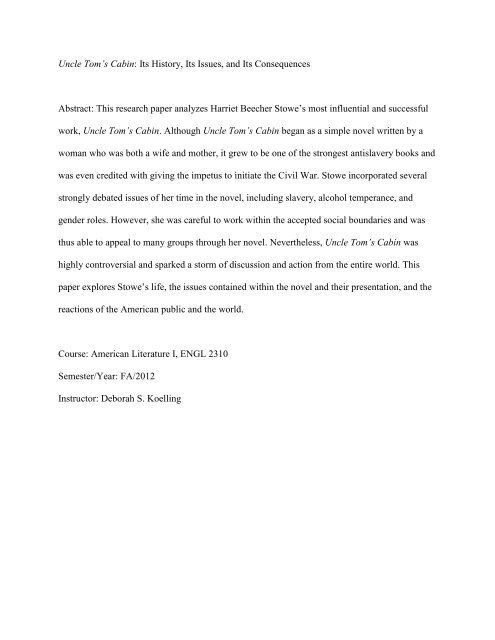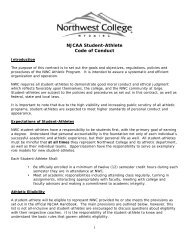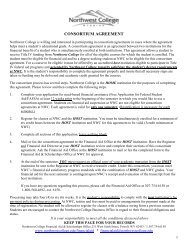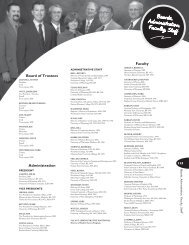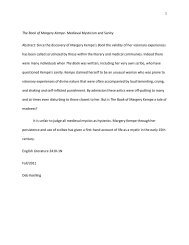Uncle Tom's Cabin
Uncle Tom's Cabin
Uncle Tom's Cabin
Create successful ePaper yourself
Turn your PDF publications into a flip-book with our unique Google optimized e-Paper software.
<strong>Uncle</strong> Tom’s <strong>Cabin</strong>: Its History, Its Issues, and Its Consequences<br />
Abstract: This research paper analyzes Harriet Beecher Stowe’s most influential and successful<br />
work, <strong>Uncle</strong> Tom’s <strong>Cabin</strong>. Although <strong>Uncle</strong> Tom’s <strong>Cabin</strong> began as a simple novel written by a<br />
woman who was both a wife and mother, it grew to be one of the strongest antislavery books and<br />
was even credited with giving the impetus to initiate the Civil War. Stowe incorporated several<br />
strongly debated issues of her time in the novel, including slavery, alcohol temperance, and<br />
gender roles. However, she was careful to work within the accepted social boundaries and was<br />
thus able to appeal to many groups through her novel. Nevertheless, <strong>Uncle</strong> Tom’s <strong>Cabin</strong> was<br />
highly controversial and sparked a storm of discussion and action from the entire world. This<br />
paper explores Stowe’s life, the issues contained within the novel and their presentation, and the<br />
reactions of the American public and the world.<br />
Course: American Literature I, ENGL 2310<br />
Semester/Year: FA/2012<br />
Instructor: Deborah S. Koelling
1<br />
<strong>Uncle</strong> Tom’s <strong>Cabin</strong>: Its History, Its Issues, and Its Consequences<br />
When she wrote <strong>Uncle</strong> Tom’s <strong>Cabin</strong>, Harriet Beecher Stowe had no idea that she was<br />
unleashing a literary giant on the world. Stowe herself was a good wife and mother, and her<br />
accomplishment is astonishing for both its near-radical ideas and for its traditional presentation,.<br />
Some of the strength of the novel is drawn from Stowe’s own life experiences and struggles,<br />
further intensifying the message of <strong>Uncle</strong> Tom’s <strong>Cabin</strong>. In fact, Abraham Lincoln is quoted as<br />
saying, “so this is little woman who caused the great war!” (in reference to the Civil War, qtd. in<br />
Seiler 136). It is true that the novel sparked outrage and sympathy on behalf of the slaves for the<br />
sensitive treatment of the slave families and hardships, and the entire world was moved to react<br />
against or for <strong>Uncle</strong> Tom’s <strong>Cabin</strong>. Thus, <strong>Uncle</strong> Tom’s <strong>Cabin</strong>, one of the greatest literary works<br />
of the 19 th century, is the outcome of Stowe’s own life and the struggles of the time period<br />
regarding slave laws and societal roles, and the novel’s worldwide success and its outcomes have<br />
served to immortalize Stowe and her writing forever.<br />
Stowe herself was an extraordinary woman from an extraordinary family. According to a<br />
biographical article by Grace Seiler, Stowe was a native of New England and her father, Lyman<br />
Beecher, was a Puritan minister who brought his children up in strong faith. Stowe was one of<br />
eight children born to Lyman Beecher and his wife, Roxana Foote. Among those children, Stowe<br />
was the only girl—and thus the only child who could not go into the ministry. Stowe seemed<br />
well-suited for the ministry, but she wrote works to replace the might-have-been career. One of<br />
these was <strong>Uncle</strong> Tom’s <strong>Cabin</strong>. When Stowe was only five years old, her beloved mother died,<br />
leaving the family bereft (Seiler 128). When her father remarried, Stowe’s new stepmother could<br />
never replace Roxana in the hearts of the children.
2<br />
According to Seiler, Stowe learned almost everything from her father—theology,<br />
philosophy, writing, an appreciation for the dramatic (her father was an exuberant, vivid man),<br />
and much more. While she idolized her father, she struggled throughout her life with the Puritan<br />
religion that her father preached. He eschewed “natural religion,” the idea that faith could come<br />
only from the heart; in truth, he believed that faith could only come through teaching. Stowe<br />
continuously searched for a loving God as she struggled with the stern doctrine of predestination,<br />
and her relationship with God changed frequently. For instance, as a child, she first converted<br />
when her father preached on Jesus’ love for man (a theological aberration for him), but when her<br />
siblings plagued her for succumbing to ‘natural religion,’ she was soon overcome by doubts<br />
about her faith—a condition that lasted for years (Seiler 130). Later on, Stowe rebelled against<br />
the coldness of some aspects of Puritanism and incorporated her passion against such doctrines<br />
in her writings, and by 1832, she had worked out her own theology. She determined to forget all<br />
of her own ambitions so that she could work entirely for others (Seiler 131). In this way, she was<br />
able to overcome most of her fears about the nature of God. Her theology of a loving God later<br />
came out clearly in <strong>Uncle</strong> Tom’s <strong>Cabin</strong>.<br />
Seiler also records that, in 1834, Harriet Beecher married Calvin Stowe after her father<br />
introduced her to him. The couple was unevenly matched in temperament, as she was passionate,<br />
vivacious, loving, and imaginative while he was somber and stubborn. She also provided most of<br />
the family’s income through her writing (Seiler 133). According to an article by Elizabeth<br />
Ammons, the two had seven children together, one of whom died in a cholera epidemic in<br />
Cincinnati. This event actually provided some of the emotional basis for <strong>Uncle</strong> Tom’s <strong>Cabin</strong>,<br />
particularly for her poignant creation of family bonds such as Eliza’s with her son, Harry. In fact,<br />
Stowe later came to believe that she was the one chosen by God to write <strong>Uncle</strong> Tom’s <strong>Cabin</strong>
3<br />
because she was a mother (Ammons 161). She began to write the novel when she was 41 years<br />
old and published it in 1851.<br />
When writing <strong>Uncle</strong> Tom’s <strong>Cabin</strong>, Stowe faced numerous challenges because of the<br />
variety in her audience and the ideas she hoped to dispel. The novel primarily focuses on the<br />
need to eradicate slavery, but Stowe also presents her beliefs about the roles of men and women,<br />
alcohol temperance, and moral reform (particularly in regard to the sexual exploitation of<br />
slaves). However, the novel does not attack these issues head-on, as David Reynolds notes in his<br />
biographical book. <strong>Uncle</strong> Tom’s <strong>Cabin</strong> filters “the most subversive, sensational, or raucous<br />
cultural energies of the time through the cult of domesticity, which put the home and the family<br />
at the center of life” (Reynolds 43). In other words, Stowe focuses on her area of expertise—the<br />
home and family—so that she can effectively communicate her ideas without being rejected as a<br />
radical feminist. Her achievements stem from her acceptable presentation of the material.<br />
Although many ideas in <strong>Uncle</strong> Tom’s <strong>Cabin</strong> are important, the most enduring and<br />
significant is that of the evil of slavery. Stowe’s focus on the need to eradicate slavery comes<br />
primarily from her own past and from the experiences of her family; throughout her life, she<br />
heard multiple stories of the sexual exploitation of slaves, and she fought against this in <strong>Uncle</strong><br />
Tom’s <strong>Cabin</strong>. In fact, as Reynolds notes, Stowe’s aunt, Mary Foote, once married a Jamaican<br />
planter, but when she discovered that he had “sired several of his slaves,” she left him and<br />
returned to America (Reynolds 59). Stowe also had a Black housekeeper, Eliza Buck, who had<br />
been the mistress of her former Kentucky owner (Reynolds 59). These events and stories in<br />
themselves provided Stowe with adequate motivation to fight slavery, and she thus combated it<br />
by directly and indirectly criticizing the injustice of the slave laws of her times.
4<br />
Religion and law are inextricably connected in <strong>Uncle</strong> Tom’s <strong>Cabin</strong>, and, according to<br />
Alfred Brophy’s analysis of Stowe’s use of slave law, “Stowe develops the links between law<br />
and slavery by indicating that the law makes it impossible for even ‘kind’ masters to make<br />
slavery humane, and that the law releases the worst impulses of unkind masters” (Brophy 468-<br />
469). The most pervasive evil that Stowe fought was a widespread belief that slavery was moral<br />
and that evil masters were rare. However, the laws made it possible for evil masters (defined by<br />
religious morality) to commit injustices without punishment. In <strong>Uncle</strong> Tom’s <strong>Cabin</strong> itself, this is<br />
demonstrated when George Shelby is forced to sell Tom and Harry to pay his debts, and the law<br />
permits—and even urges—him to ignore the basic human rights of his slaves in favor of<br />
maintaining his lavish lifestyle. In other words, his obligation to pay his debts of honor,<br />
according to the law, trumps his obligation to his human dependents. Thus, Tom is sold to the<br />
callous Mr. Haley, who cares only for profits (Stowe 8). In addition, not only did the laws enable<br />
cruelty to slaves, but the slave laws actually made it illegal for masters to act kindly toward their<br />
slaves. This is shown by the fact that, as Brophy states, “to shut off the humanity [of the slaves],<br />
the slave-code prohibits masters from teaching their slaves to read and write, limits the slaves’<br />
access to education, and prohibits them from acquiring property, raising their own animals, or<br />
hiring themselves out for their own benefit” (Brophy 472-473). Furthermore, slave-owners were<br />
urged not to free their slaves. Slave-owners were actually extremely limited in their ability to<br />
simultaneously comply with the laws and to treat their slaves as human beings.<br />
Slaves were often left to despair because they had no governmental protection<br />
whatsoever. Many such cases exist in <strong>Uncle</strong> Tom’s <strong>Cabin</strong>. For instance, George is legally taken<br />
from his profitable and fulfilling employment to a life of hard labor and misery because of his<br />
master’s jealousy over his slave’s success. In addition, Prue’s master kills her because of her
5<br />
constant drunkenness, which is brought on because most of her children are sold and her one<br />
remaining child dies of neglect and hunger when Prue is not permitted to care for it (Stowe 198-<br />
199). In addition, Legree cruelly punishes and eventually kills Tom for his faithfulness and<br />
refusal to reveal fugitive slaves. These examples are all illustrations of what was legal in Stowe’s<br />
time. In fact, the Fugitive Slave Law even forced Northerners to be complicit with slavery by<br />
requiring them to return fugitive slaves to their owners or by making them criminals if they<br />
helped the runaway slaves (Brophy 476).<br />
In <strong>Uncle</strong> Tom’s <strong>Cabin</strong>, then, Stowe comes to the conclusion that, if laws are unjust, men<br />
and women must obey their consciences and do the right thing, even if it is against the law. This<br />
attitude can be seen when George, Eliza, and Harry find the Birds, who help them to escape even<br />
though Senator Bird has voted for a law forbidding people even to feed or shelter runaway slaves<br />
(Stowe 78). Furthermore, the fugitive family is taken in and sheltered by a Quaker community.<br />
However, according to Brophy, the idea of defiance to unjust laws is actually summed up in the<br />
climax of the novel when Tom refuses to tell Legree the whereabouts of Cassie and Emmeline,<br />
where Stowe most clearly challenges slave law and encourages disobedience to the unjust and<br />
immoral laws (Brophy 478). Nevertheless, Stowe makes it abundantly clear that such rebellion<br />
should not be violent; on the contrary, Tom peacefully resists his master. Through <strong>Uncle</strong> Tom’s<br />
<strong>Cabin</strong>, then, Stowe is able to point out the injustices and the depravity of the slave laws and the<br />
widespread need to rise up against the laws that afforded the slaves no protection and forced<br />
people to act against their consciences to comply with slavery.<br />
In addition to confronting slavery, Stowe fights other moral battles in the book, some<br />
more indirectly than others. One cause that she addresses subtly is that of alcohol temperance.<br />
For instance, in the opening scene of <strong>Uncle</strong> Tom’s <strong>Cabin</strong>, Mr. Shelby and Mr. Haley are drinking
6<br />
while discussing the fates of Eliza Harris and her son Harry. Later on, the men hunting the Harris<br />
family (Eliza, George, and Harry) are in drunken rages. Furthermore, it is enlightening to note, as<br />
Reynolds states in his article, that “Augustine St. Clare is killed when he tries to break up a brawl<br />
between drunken men in a café. The enslaved woman Prue, after years of sexual exploitation,<br />
becomes a wretched alcoholic … another sex slave, Cassy drinks to drown her despair … [and]<br />
the nefarious Simon Legree overindulges in drink” (Reynolds 57). All of these instances, and<br />
more, demonstrate the pervasive evil of alcohol use in <strong>Uncle</strong> Tom’s <strong>Cabin</strong>. In accordance with<br />
this, Stowe’s best characters, including the Birds, the Quakers, and Tom himself, all abstain from<br />
alcohol entirely. Thus, Stowe tries to send a subtle message to her readers about the evil of<br />
alcohol abuse.<br />
However, despite the strong opinions expressed in <strong>Uncle</strong> Tom’s <strong>Cabin</strong> about reform<br />
topics, Stowe is careful to work within the accepted social boundaries, thus making her book<br />
more acceptable to her readers. After all, as Reynolds points out, if Stowe had not tempered her<br />
ideas with conventional presentation, she would likely have been dismissed as a radical<br />
feminist—very much like her half-sister Isabella (Reynolds 53). It is notable that Stowe<br />
primarily focuses <strong>Uncle</strong> Tom’s <strong>Cabin</strong> on the home and family, which are her own areas of<br />
expertise (as she was both a wife and mother). This gives a credible basis to the conflicting<br />
opinions about the novel. For instance, pro-slavery critics condemned Stowe as a dangerous<br />
reformer and a woman who disguised her reforming ideas as virtuous and pure Christian notions,<br />
citing the tragic and violent scenes as well as the strongly opinionated characters of the novel as<br />
indications of Stowe’s disquieting messages; on the other hand, the novel was heralded as a<br />
conservative and feminine novel. These radically opposing viewpoints served to place Stowe on<br />
middle ground regarding feminism and a number of other issues (Reynolds 45). However, it is
7<br />
true that in <strong>Uncle</strong> Tom’s <strong>Cabin</strong>, many women are strong characters, even within their traditional<br />
positions as wives and mothers. Stowe does not suggest that women should occupy other<br />
positions, but believes that women can be important and influential even inside the home<br />
(Reynolds 47). Eliza is a perfect example of this, given that she does her utmost to protect her<br />
family by being strong when needed, such as when she runs across the frozen Ohio.<br />
Furthermore, as Elizabeth Ammons emphasizes in her article, Stowe actually feminizes<br />
her most amenable characters and, as a mother, invokes motherly images and feelings in order to<br />
demonstrate the destitution that slavery imposed upon slave families. Throughout <strong>Uncle</strong> Tom’s<br />
<strong>Cabin</strong>, Stowe linked Tom, Eva, and most mothers—excepting Eva’s mother, Marie St. Clare—<br />
through feminine qualities. All of these qualities are shared with most of the women in the novel,<br />
including Mrs. Bird, Aunt Chloe, Eva, and the virtuous Quaker women. These characters were<br />
also all linked to the anti-slavery movement, particularly the slave mothers, as “Stowe places<br />
particular emphasis on the horrors suffered by the system’s maternal victims” (Ammons 167).<br />
However, many of these women are notable for remaining within their spheres (the home and<br />
family) even when combating slavery. For instance, Eliza Harris never rebels against the<br />
conventional views of wives and mothers; the only time that she actually revolts is when her son<br />
and her family are threatened. It is here that Stowe, through Eliza, shows that family values and<br />
responsibilities can indeed trump law. Through connections such as that between virtuous<br />
womanhood and the evils of slavery, Stowe creates parental sympathy for the atrocities heaped<br />
upon slave families, to show that black people are humans with human emotions, and, as<br />
Ammons remarks in her article, “that women suffer horrible tortures in the midst of a society<br />
boastful about its chivalry toward the ‘gentle sex’” (Ammons 167).
8<br />
Stowe also uses a feminized Tom in presenting her values and observations about the<br />
conflicts within the slave-based system. Throughout <strong>Uncle</strong> Tom’s <strong>Cabin</strong>, Stowe focuses on<br />
men’s roles and behaviors in her society and questions the validity of the popular perceptions of<br />
men. During Stowe’s time period, traditional masculinity tended to lean toward tactics of<br />
aggression; as Cynthia Wolff states in her article, “By [the] mid-nineteenth century, a formulaic<br />
image of a ruthless, power-hungry American manhood had developed …. Traits such as selfsacrifice<br />
and sensitivity to the needs of others were anathema to this crude masculine stereotype”<br />
(Wolff 599). To combat this attitude, Stowe used feminine heroes such as Tom. After all, if her<br />
society defined masculinity based on principles of competition and conquest, Stowe decided that<br />
masculinity needed a new definition if slavery were to be combated (Wolff 600). It is thus<br />
interesting that Tom, the main character of the novel, is, as Elizabeth Ammons mentions,<br />
“gentle, pious, chaste, domestic, long-suffering and self-sacrificing” (Ammons 162). Therefore,<br />
Tom is characterized by meekness, servility, faith, devotion to his family, and a protective,<br />
loving nature. Furthermore, he is entirely nonviolent; there is not a single instance in the novel in<br />
which he engages in violent behavior to protect himself. Even when protecting others, as in his<br />
final confrontation with Legree, Tom simply refuses to tell Legree where Cassy and Emmeline<br />
are and meekly bears Legree’s fury, even accepting death for the protection of others (Stowe<br />
376). In stark contrast to Tom’s feminine virtue, those who demonstrate traditional masculinity<br />
actually become villains. Among these, Legree is the most degraded man in the novel, but he is<br />
also the man who is most “masculine,” according to Stowe’s society’s definition. By presenting<br />
Tom the way she does, Stowe manages to create sympathy for the black race and illustrate her<br />
idea of perfect masculinity.
9<br />
When it was published, <strong>Uncle</strong> Tom’s <strong>Cabin</strong> had far-reaching ramifications. The novel<br />
instantly became a smash hit around the globe—popular international icons praised it, and<br />
abolitionists and pro-slavery parties both reacted strongly to it; it became a household book, and<br />
it had dramatic consequences regarding slavery. When Stowe published <strong>Uncle</strong> Tom’s <strong>Cabin</strong> in<br />
1851, it earned her $10,000 in the first four months. In fact, Grace Seiler observes in her article<br />
that Stowe’s novel had such a powerful effect in America that “for a time, at least, the power of<br />
<strong>Uncle</strong> Tom’s <strong>Cabin</strong> was so great as to make the enforcement of the Fugitive Slave Law<br />
impossible” (Seiler 135). Stephen Hirsch also points out in his article that famous individuals<br />
such as the Pope, a Russian diplomat, and George Sand reacted favorably to the book.<br />
Furthermore, <strong>Uncle</strong> Tom’s <strong>Cabin</strong> became so famous that one of the most popular names for<br />
infant girls was Eva. Stowe later said that God wrote the novel through her; surely nothing that a<br />
mere human wrote could have such an impact on the world (Hirsch 303).<br />
One of the most significant reactions to <strong>Uncle</strong> Tom’s <strong>Cabin</strong> was an outbreak of literary<br />
efforts imitating and exalting Stowe’s work. Newspapers and magazines were especially<br />
important to this eruption of reviews and literature, as they ran articles about <strong>Uncle</strong> Tom’s <strong>Cabin</strong><br />
and noted its growing popularity:<br />
The Liberator [the Boston abolitionist paper] also joyously reported that the novel<br />
had been adopted as a Sunday school text in both Peoria and Pittsburgh, and<br />
Frederick Douglass’ Paper approvingly noted its use in several high schools. The<br />
Pennsylvania Freeman reported that the Delaware Anti-Slavery society had<br />
donated a copy of <strong>Uncle</strong> Tom to every library in the state, and Douglass’ organ<br />
boasted that the New York Mercantile Library alone had no fewer than forty-six<br />
copies in circulation. (Hirsch 304)
10<br />
Through book sales alone, it is clear that <strong>Uncle</strong> Tom’s <strong>Cabin</strong> had drastic effects<br />
throughout America and the entire world. However, the reaction to the novel was even more<br />
apparent through the massive literary output that responded to <strong>Uncle</strong> Tom’s <strong>Cabin</strong>. Newspaper<br />
articles, letters, essays, poems, songs, plays, and merchandise burst from America in honor of—<br />
or in reaction to—Stowe’s novel. To demonstrate this, Stephen Hirsch cites poetical efforts in his<br />
article such as Francis E. Watkins’s “Eva’s Farewell” and “Eliza’s Flight,” as well as Mrs. R.S.<br />
Nichols’s “Gentle Eva.” Anti-Tom poems also exist, but they are few. These include William<br />
Grayson’s “The Hireling and the Slave” and a New York lady’s “The Patent Key to <strong>Uncle</strong> Tom’s<br />
<strong>Cabin</strong>” (Hirsch 308-309). However, many of the anti-Tom poems and other writings “reveal a<br />
hidden tone of fear and helplessness” (Hirsch 308). Perhaps this indicates that the authors<br />
themselves had reservations about the rightness of slavery and feared that they would be<br />
overcome by the abolitionist cause.<br />
Musical efforts also resulted from the publication and popularity of <strong>Uncle</strong> Tom’s <strong>Cabin</strong>.<br />
However, the songs often romanticized events or characters and sometimes completely bypassed<br />
actual events in the novel. For instance, Eva is a popular character in many such songs, but<br />
instead of portraying her as Stowe described her (a cheerful, Christ-like child), most songwriters<br />
choose instead to focus on Eva’s death and her sanctity. An example of this is in “<strong>Uncle</strong> Tom’s<br />
Lament for Eva,” where the author mourns,<br />
“For ‘twas in the night they laid you<br />
Dear Eva, in thy grave,<br />
E’en now my heart is breaking<br />
O, God, in pity save” (Hirsch 314).
11<br />
This clearly demonstrates the sentimentality and morose tones of many of the songs and poems<br />
that were written in the wake of <strong>Uncle</strong> Tom’s <strong>Cabin</strong>. Furthermore, for the most part, such<br />
tributes to <strong>Uncle</strong> Tom’s <strong>Cabin</strong> fall far short of the mark. Many are artistically deficient, wih<br />
authors of the poems and songs basically looking to prosper from Stowe’s monumental success.<br />
<strong>Uncle</strong> Tom’s <strong>Cabin</strong> merchandise was also distributed almost everywhere. The book itself<br />
was printed in numerous forms for different audiences. For instance, according to Stephen<br />
Hirsch, the publisher Jewett published a “lavish, gorgeously bound, profusely illustrated<br />
Christmas gift edition at the overwhelming price of five dollars” (Hirsch 316). This edition<br />
followed several other printings, including the original three-dollar printing and a later “thirtyseven-and-a-half<br />
cent paperbound ‘edition for the millions’” (Hirsch 316). Jewett also printed an<br />
edition for children titled Pictures and Stories from <strong>Uncle</strong> Tom’s <strong>Cabin</strong>—severely expurgated, of<br />
course. Clothing trends even imitated the fashions in the book, including “St. Clare hats,” “<strong>Uncle</strong><br />
Tom Tippets,” and Eliza dresses (Hirsch 316-318). Figurines, collectible dishware, paintings,<br />
scarves, card games and other toys, and the like were also among the <strong>Uncle</strong> Tom’s <strong>Cabin</strong><br />
merchandise sold (Hirsch 316, 318-319, 322). <strong>Uncle</strong> Tom’s <strong>Cabin</strong> was clearly a hit—and the<br />
sales of such products proved it.<br />
However, the most significant reaction to <strong>Uncle</strong> Tom’s <strong>Cabin</strong> has been through theatrical<br />
productions. Such theatricals have been long-lasting and have shaped American culture<br />
considerably; for instance, George Aiken’s dramatization of the novel may have been the most<br />
influential and successful of the <strong>Uncle</strong> Tom’s <strong>Cabin</strong> theatricals. In fact, Hirsch maintains that<br />
when the Troy Daily Times of New York State predicted that Aiken would succeed, “the Times<br />
had made the biggest understatement in American theater history” (Hirsch 321). It was so<br />
successful that, by the time Aiken completed his dramatization of the novel’s second volume, the
12<br />
resulting drama played “a total of one hundred performances, a record unbroken in Troy to this<br />
day” (Hirsch 323).<br />
Furthermore, when Aiken’s play traveled to New York City, other playwrights caught<br />
onto the fact that <strong>Uncle</strong> Tom’s <strong>Cabin</strong> was a fantastic moneymaker, and several plays about the<br />
novel soon traveled throughout the United States to Europe within three years, further<br />
contributing to the massive popularity of Stowe’s novel (Hirsch 325). In fact, such theatrical<br />
influences can be seen even today, as in the Rodgers & Hammerstein production of The King<br />
and I, in which a Siamese rendition of <strong>Uncle</strong> Tom’s <strong>Cabin</strong>—“The Small House of <strong>Uncle</strong><br />
Thomas”—is portrayed.<br />
Although the most fantastic theatrical performances seem to have come from the pro-<br />
Tom side, the South also produced proslavery works to try to counteract the monumental effect<br />
of the antislavery productions. For instance, pro-slavery/anti-Tom theatricals include Joseph M.<br />
Fields’ <strong>Uncle</strong> Tom’s <strong>Cabin</strong>: or, Life at the South as it Is, Dr. William T. Leonard’s <strong>Uncle</strong> Tom’s<br />
<strong>Cabin</strong> in Louisiana, George Jamison’s The Old Plantation; or, <strong>Uncle</strong> Tom as he Is Check<br />
capitalization, Marco Mingle’s <strong>Uncle</strong> Tom’s <strong>Cabin</strong> in England, and many more (Hirsch 326).<br />
Some of these proslavery theatricals did have strong influences, but the majority fell short of<br />
their mark.<br />
In truth, Harriet Beecher Stowe’s <strong>Uncle</strong> Tom’s <strong>Cabin</strong> has had a remarkable effect<br />
throughout the world; its creation began with events in Stowe’s life that add credibility and<br />
relevance to the story, Stowe builds on this foundation with her own interpretations and purposes<br />
(such as redefining masculinity and eliminating alcohol abuse in order to abolish slavery), and<br />
this combination has resulted in the novel’s enormous popularity and reach throughout the world.<br />
The key to her success, however, is that she utilizes traditional formats and presentations to
13<br />
frame her ideas, thus making her position on slavery acceptable and relatable worldwide.<br />
Stowe’s accomplishment is phenomenal, and perhaps it is indeed true that God wrote <strong>Uncle</strong><br />
Tom’s <strong>Cabin</strong> through this little woman, providing the momentum needed for America to hurtle<br />
into the Civil War and to outlaw slavery.
14<br />
Works Cited<br />
Ammons, Elizabeth. “Heroines in <strong>Uncle</strong> Tom’s <strong>Cabin</strong>.” American Literature 49.2 (1977): 161-<br />
179. JSTOR. Web. 9 Sept. 2012.<br />
Brophy, Alfred. “Over and Above…There Broods a Portentous Shadow,—The Shadow of the<br />
Law: Harriet Beecher Stowe’s Critique of Slave Law in <strong>Uncle</strong> Tom’s <strong>Cabin</strong>.” Journal of<br />
Law and Religion 12.2 (1995-1996): 457-506. JSTOR. Web. 14 Sept. 2012.<br />
Hirsch, Stephen A. “<strong>Uncle</strong> Tomitudes: The Popular Reaction to <strong>Uncle</strong> Tom’s <strong>Cabin</strong>.” Studies in<br />
the American Renaissance (1978): 303-330. JSTOR. Web. 26 Sept. 2012.<br />
Reynolds, David S. Mightier Than the Sword: <strong>Uncle</strong> Tom’s <strong>Cabin</strong> and the Battle for America.<br />
New York: Norton, 2011. Print.<br />
Seiler, Grace. “Harriet Beecher Stowe.” College English 11.3 (1949): 127-137. JSTOR. Web. 26<br />
Sept. 2012.<br />
Stowe, Harriet Beecher. <strong>Uncle</strong> Tom’s <strong>Cabin</strong>. 1852. Ed. Elizabeth Ammons. Norton Critical<br />
Editions. New York: Norton, 2010. Print.<br />
Wolff, Cynthia Griffin. “‘Masculinity’ in <strong>Uncle</strong> Tom’s <strong>Cabin</strong>.” American Quarterly 47.4 (1995):<br />
595-618. JSTOR. Web. 9 Sept. 2012.


